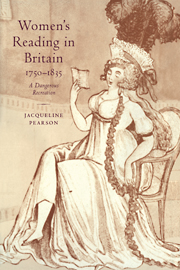Book contents
- Frontmatter
- Contents
- Preface
- Introduction
- 1 Pygmalionesses and the pencil under the petticoat: Richardson, Johnson and Byron
- 2 What should girls and women read?
- 3 The pleasures and perils of reading
- 4 Pleasures and perils of reading: some case histories
- 5 Where and how should women read?
- 6 Preparing for equality: class, gender, reading
- 7 A dangerous recreation: women and novel-reading
- Conclusion
- Notes
- Select bibliography
- Index
7 - A dangerous recreation: women and novel-reading
Published online by Cambridge University Press: 22 October 2009
- Frontmatter
- Contents
- Preface
- Introduction
- 1 Pygmalionesses and the pencil under the petticoat: Richardson, Johnson and Byron
- 2 What should girls and women read?
- 3 The pleasures and perils of reading
- 4 Pleasures and perils of reading: some case histories
- 5 Where and how should women read?
- 6 Preparing for equality: class, gender, reading
- 7 A dangerous recreation: women and novel-reading
- Conclusion
- Notes
- Select bibliography
- Index
Summary
The argument about women's reading centred on the novel, with novel-reading one of the most contested areas in cultural debate. The Lady's Magazine, for example, ran a series of articles on novel-reading, representing virtually all imaginable ideological positions. Novels were subject to large-scale ‘obloquy and censure’, but this did not convince either the reading public or less repressive critics who defended them on grounds both aesthetic and moral. In reviews of novels, unlike other genres, ‘questions of audience came into explicit focus’, with novelreading attributed to ‘the young, the ignorant and the idle’, and especially the female. A ‘stable’ – and ‘negative’ – association was drawn between women and fiction, and in reviews novel-readers were ‘commonly … figured as female’ rather than the implied reader, the ‘gentleman or the scholar’ of traditionally sanctioned genres.
The anti-novel literature is voluminous and repetitive: the same stereotypes, like the vulnerability of the novel-reading girl to seduction, and even the same words, like ‘poison’ and ‘soften’, recur compulsively. This certainly suggests, as E. J. Clery maintains, that arguments about the novel were really about larger issues, ‘unregulated social and economic forces, and the erosion of established hierarchies of value and authority’, displaced on to a more manageable canvas, and that relocating these arguments on to the novel disguised a culture-specific issue as one allegedly of timeless universality, female sexuality. Nonetheless, I shall proceed on the assumption that these arguments may have been about more than the novel, but were also about the novel.
- Type
- Chapter
- Information
- Women's Reading in Britain, 1750–1835A Dangerous Recreation, pp. 196 - 218Publisher: Cambridge University PressPrint publication year: 1999



